Serpentine belt, tensioner: problems, signs of wear, when to replace, noises
Updated: November 17, 2018
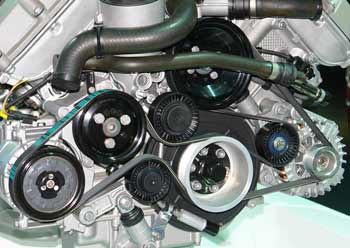 Serpentine belt.
Serpentine belt.
If you open the hood in a modern car with a gasoline or diesel engine, you will see at least one serpentine belt. See this photo. There are cars with two or three belts; electric cars have no belts. The job of a serpentine belt is to drive accessories installed on your engine such as an alternator, water pump and air conditioner compressor.
A serpentine belt is different from a timing belt. A timing belt runs the engine camshaft(s) and is hidden under protective covers. A serpentine belt is located on the side of the engine and can be inspected from under the hood. What happens if a serpentine belt breaks? What can cause a belt to squeal? When should you replace a serpentine belt? How expensive is it?
What happens if a serpentine belt breaks?
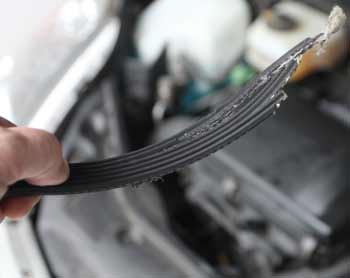 Broken serpentine belt.
Broken serpentine belt.
If a serpentine belt breaks, a car won't be drivable and will have to be towed. If the engine runs without a serpentine belt, it might overheat as the water pump will no longer work. A broken belt can also damage other parts. We have seen broken radiator shrouds and ripped coolant hoses that were damaged by a ripped belt.
Symptoms of a broken serpentine belt include loud slapping, squealing or knocking noises coming from under the hood. The battery-shaped charging system warning light might also come on because the alternator will stop charging the battery. If a car has a hydraulic power steering pump, the steering will become stiff.
Common belt and tensioner problems that can cause a belt to break or produce noises
Here are several common problems:
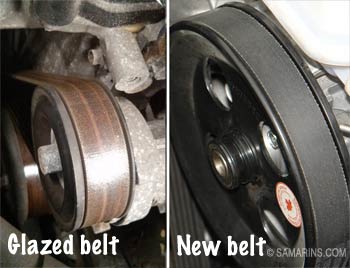 Glazed serpentine belt vs. a new belt.
Glazed serpentine belt vs. a new belt.
1. Regular wear and tear. A new serpentine belt has a soft felt-like surface on the ribbed side. As the belt wears out, the belt rubber hardens and cracks; scroll down to see the photo of a cracked belt. A worn-out belt stretches and loses tension. This causes the belt to start slipping from time to time. You might hear it when the engine is started in the morning or in wet weather as squealing or chirping noises coming from under the hood. The belt may also appear glazed as in this photo.
If there are no other problems and the belt tensioner is in good shape, a new serpentine belt should fix this problem. Replacing a serpentine belt costs from $18-$75 part plus $50-$150 labor.
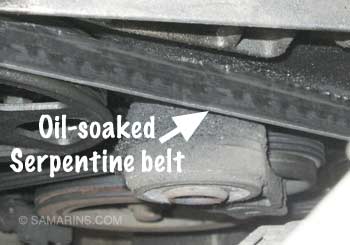 Oil leaks can damage a serpentine belt in a short period of time.
Oil leaks can damage a serpentine belt in a short period of time.
2. Oil leaks. Sometimes, an engine develops oil leaks around the belt area, which causes the belt to get soaked in oil, see the photo. Oil or coolant can damage the serpentine or timing belt fast.
We have seen a new serpentine belt that lasted less than a week in an engine that leaks oil around the belt area. In this case, there is no point installing a new belt. Oil leaks have to be fixed first.
Price to repair oil leaks will depend on the source of the leak. Replacing a valve cover gasket is not expensive ($120-$300), but if the leak is coming from a camshaft seal or other sources, the repair will be more complicated.
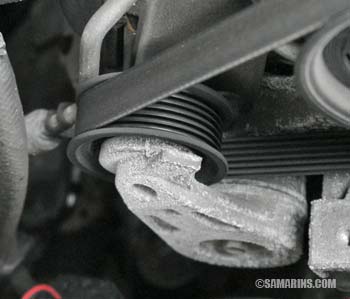 An automatic spring-loaded belt tensioner can seize up inside or wear out on its shaft
An automatic spring-loaded belt tensioner can seize up inside or wear out on its shaft
3. Bad spring-loaded automatic belt tensioner. Proper tension is vital for any belt. Often an old spring-loaded automatic belt tensioner seizes up or wears out and becomes weak. Without proper tension a serpentine belt will start slipping. This will cause the belt to wear faster.
We have seen seized belt tensioners causing a loose serpentine belt to roll off the tensioner. The symptoms of a loose serpentine belt include a loud squealing noise when the engine is started or when the steering is turned all the way to one side. A serpentine belt that keeps slipping off the pulley is another symptom of a bad tensioner.
The solution is to replace a serpentine belt and a belt tensioner. A spring-loaded automatic belt tensioner costs $20-$50 for the part, plus the labor ($75-$170).
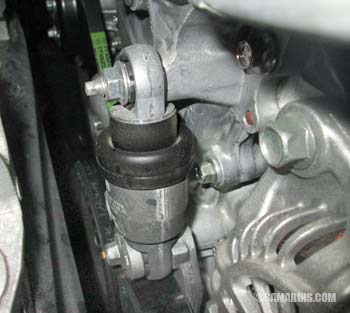 Often you can spot a hydraulic belt tensioner like this one is leaking oil.
Often you can spot a hydraulic belt tensioner like this one is leaking oil.
4. Problems with hydraulic belt tensioner. Many cars have a hydraulic serpentine belt tensioner, where instead of the spring the tension is maintained by a little "shock absorber" (in the photo). It too can fail.
Symptoms include a leak from the tensioner or a rattling noise from the belt area when the engine is running. This item is common to fail in many cars including Toyota Corolla, Matrix, BMW and Mazda cars.
The fix is the same; a bad tensioner must be replaced. The belt should be replaced too, unless it's in like-new condition. A hydraulic belt tensioner costs anywhere from $35 to $75. The labor to replace it is $75-$170.
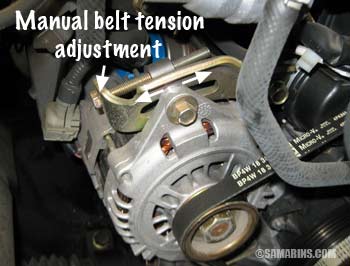 Mazda Miata manual drive belt tensioner adjustment.
Mazda Miata manual drive belt tensioner adjustment.
5. Manual belt tension is out of adjustment. In some cars the belt tension is adjusted manually, see the photo. Here is another example: the belt tension adjustment in Toyota Yaris. Over time, the belt stretches and if the tension is not adjusted in time, the belt will start slipping. You have probably seen it: an older Japanese or Korean car makes a loud screeching noise when started.
The solution is simple: if the belt is still in good shape, the tension needs to be re-adjusted. If the belt is bad, it needs to be replaced and properly tightened.
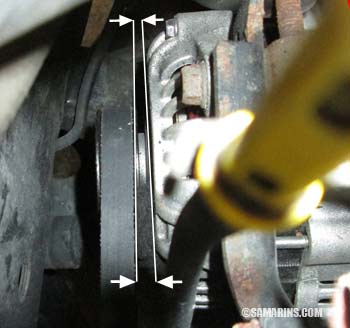 The alternator in this photo is not lined up with the belt and other pulleys. This caused the belt to squeal and wear faster.
The alternator in this photo is not lined up with the belt and other pulleys. This caused the belt to squeal and wear faster.
6. Misaligned belt pulley. A serpentine belt runs on several pulleys. If any of the belt-driven devices or a tensioner pulley for some reason is not lined up with the belt, the belt will squeal. Often this problem is discovered after a newly replaced belt still squeals or wears out fast. One of the symptoms of this problem is increased wear on one side of the belt.
Sometimes, you can visually see when one of the pulleys is not lined up. For example, in this car, in the photo, an alternator and a belt have been replaced while on a trip, a few weeks ago. Now the belt squeaks. Upon closer inspection, we found that the alternator was loose and shifted under angle. This caused the alternator pulley to be misaligned with the belt, so the belt was squealing and wearing out faster. If you look closer in the photo, you can see rubber shavings in the area between the belt and the alternator.
The fix, in this case, was to replace the belt and worn-out alternator bolts to align the alternator.
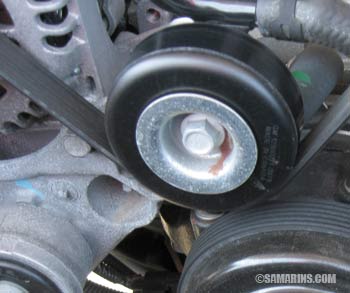 A failed bearing in one of the idler pulleys like this one is another common source of the noise.
A failed bearing in one of the idler pulleys like this one is another common source of the noise.
7. Noisy idler pulley or tensioner bearing. To route a serpentine belt, many cars use free-spinning pulleys like the one in the photo. It's called an idler pulley. It spins on a little bearing. When that bearing goes bad, it can produce a whining/whirring or screeching noise. Because several belt-driven devices can make a similar noise, this one might take some time to diagnose.
Mechanics use a special stethoscope to look for the source of noise. A bad bearing inside the alternator, A/C compressor or power steering pump produces the same type of noise. A mechanic might have to remove a belt and check the devices that are run by a belt one by one.
The repair will depend on what part is bad. If it's just an idler, it's not very expensive: $15-$35 for the part plus $60-$170 labor. Replacing an A/C compressor or alternator could cost from $450 to $850.
When a serpentine belt needs to be replaced
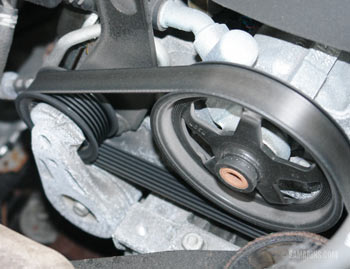 This serpentine belt is still in good shape, no need to replace it yet.
This serpentine belt is still in good shape, no need to replace it yet.
A serpentine belt can last from 30,000 to over 100,000 miles. Most car manufacturers don't specify the serpentine belt replacement intervals, but rather recommend inspecting the belt during regular services. For example, this is what Toyota recommends for the serpentine belt in the 2017 Toyota Camry:
Initial inspection at 60,000 miles/72 months. Inspect every 15,000 miles/18 months thereafter.
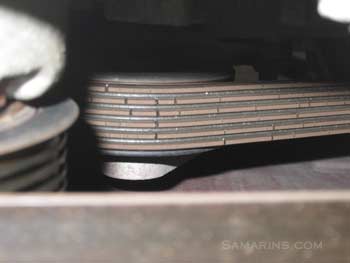 This serpentine belt shows cracks, it needs to be replaced
This serpentine belt shows cracks, it needs to be replaced
When you take your car for a regular oil change service, a mechanic will look for cracks (see the photo), splits, damaged edges, missing chunks, glazing and other signs of wear. In most cases, it's easy to see when the belt is worn out. A worn-out belt must be replaced. A serpentine belt must also be replaced if it is found to be soaked in oil or stretched.
Serpentine belt replacement cost
If your car has two belts, we recommend replacing both at the same time, because you are saving on labor. It's also a good idea to replace an old serpentine belt before a long road trip. Read more: Car checklist before a long trip. Replacing a serpentine belt costs $18-$75 part plus $50-$150 labor.
How easy is it to replace a serpentine belt DIY?
On the scale from 1 (easy) to 10 (leave it to pros) the serpentine belt replacement can be rated from 3 to 7 depending on the car. To replace a serpentine belt, you will need a belt diagram that shows the routing. For some cars, the routing is shown in the owner's manual. Another way is to draw a routing diagram before removing the old belt.
In many front-wheel drive cars with a transversely-mounted engine, the space between the engine and the frame is limited and changing a serpentine can be tricky. In some cars, a special tool is needed to release the belt tensioner. To order a serpentine belt you might need a VIN number, as the belt could be different for different years and engines. It's a good idea to compare a new belt to the old one to make sure the part is right.
If you need proper repair instructions, we posted several links at the bottom of this article, where you can get a subscription-based access to a factory service manual. Of course, there is YouTube with thousands of auto enthusiasts posting DIY videos.
Posted by: milanmilanerrettowe0266741.blogspot.com
Source: https://www.samarins.com/glossary/serpentine_belt.html